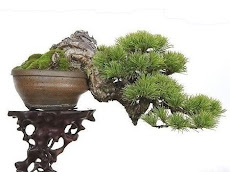
FULL Japanese Juniper Bonsai Tree in AUTHENTIC Japanese Bonsai Pot
Amazon.com:
Japanese Bonsai
Story by:
Anita ProachContrary to belief, Bonsai trees do not originate from Japan. Discoveries have been made in Egyptian tombs of sketches showing miniature trees in pots. These are thought to have been kept for decorative purposes and the pictures date back to 4000 years ago! There are also records dating back more than 2000 years that show Bonsai being grown in China.
The practice of growing trees in a pot was originally Chinese, but the practice of growing the bonsai tree was made into an art form by the Japanese when the concept was introduced to them about 5 centuries ago.This has led to quite different styles in Japanese and Chinese bonsai; the Chinese bonsai being much more freestyle and more lightly pruned than the Japanese miniature bonsai that are very heavily groomed and pruned and look much more like miniature natural versions of the full sized versions.
Many people think of tiny little Japanese trees cut and pruned to a miniature size but literally speaking, bonsai is a Japanese word, but its roots are Chinese and are derived from the word punsa meaning tree in a pot. These bonsai were not as small as the bonsai that people often envisage and were grown on an individual basis outdoors in pots. It was, though, the Japanese that took this art form and progressed it to the level it is at now.

Yoga & Zen Reflection Bonsai - Juniper Bonsai Tree by the Pond
It is a common misconception that the bonsai tree is small naturally, but this is not true. While they are smaller than their wild counterparts they do not have to be a couple of inches tall; they can be grown in a pot in the garden and will be smaller than their wild counterparts. The bonsai tree comes from the same seed as its larger counterpart, but is grown in a specific way to ensure that it remains tiny. It is vital for the beginner to know that the main element to growing a bonsai is pruning this is the technique used that allows the tree to stay small. Without regular pruning, the bonsai tree will grow to its standard height and size.
The bonsai tree can grow to various heights. There are trees that are a few inches high and some grow much taller. There are no restrictions; it is only important that the bonsai tree is grown in a pot and attains the image of a full-grown tree as it would in nature. In the beginning, growing these miniature trees may seem difficult, but it would not take long before you learn the art form of the bonsai tree and find that you simply cannot get enough of these unique plants.

A Japanese Juniper Bonsai Tree - An Authentic Japanese Bonsai
Misconceptions About Bonsai Trees.Some people believe that training Bonsai trees is a cruel pastime because the cultivator starves the tree and cuts it to such an extent that it becomes unhealthy. Quite the reverse is usually true; while they are cut and pruned quite heavily to keep them to the size of the pot, they are usually transferred from pot to pot regularly and are fed and watered much more often than their wild cousins.
Bonsai trees do not live shorter lives than wild trees. They regularly live for many centuries and are traditionally passed down from generation to generation of family. They lead nearly exactly the same length lives as their wild cousins and are often much healthier because of the attention they receive.
The Advantages of Growing Bonsai.
Unique Terrarium Bonsai for Pets with Japanese
"Water Well" Handmade Bonsai Container
Not everyone has a large garden where they can plant numerous trees and let them grow as big as they want, and even those who do have large gardens still need to wait for many years before the tree becomes truly established. By growing bonsai you do not need any more room than the size of your pot and because you only need them to grow to much smaller proportions it really is accessible for anyone who is interested in growing bonsai trees. You can even grow them inside if you can recreate the correct conditions for the tree you want to grow.
The roots of a bonsai tree have to be pruned so that it will remain healthy. By pruning the roots, it produces a small thick ball or pack of root that permits it to be transplanted to an appropriate container. When pruning the roots, one-third of the roots are removed yearly so that new soil can be added and give space for new roots to develop.
It was not until the early 1900s that the bonsai tree was introduced to the western world, but it soon became not only a popular hobby, and requires attention to detail, foresight of how the tree will grow and plenty of time and care. It began to be considered a serious art form in horticulture by many people and today, there are bonsai tree displays and shows, as well as stores dedicated to the bonsai tree. You will undoubtedly feel massive satisfaction if you decide to grow Bonsai and are any good at it.
Bringing the exquisiteness of a Japanese garden into your home with the bonsai tree is a great way to add beauty and elegance to your surroundings. If you are looking for a new type of indoor plant, or simply a new hobby, consider the bonsai tree.
About The Author
Anita Proach has always had a love for the Japanese-style. The traditions and history with the beautiful simple lines, the minimal approach to interior and exterior spaces and the blending of such wonderful elements like the bonsai, koi fish ponds, gardens, art and architecture, all working in harmony with nature.
Article Source:
http://www.articlecity.com/articles/hobbies/article_1512.shtml








